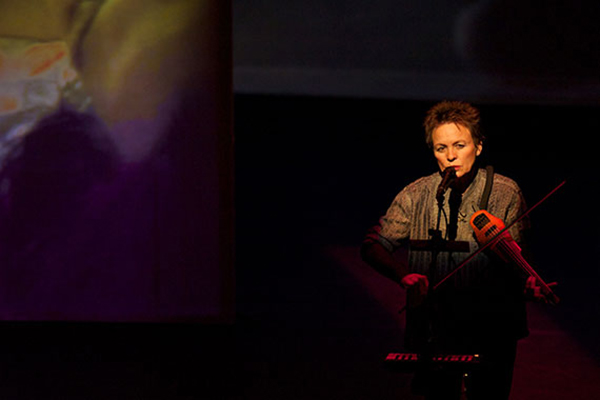UPDATE:
| Unfortunately the performance of Landfall by Laurie Anderson and Kronos Quartet scheduled for this Wednesday, October 16, at Bass Concert Hall has been canceled due to unforeseen circumstances. The “Conversation with Laurie Anderson” on Thursday, October 17, has been canceled as well. Texas Performing Arts will reschedule the performance during the 2014-2015 Texas Performing Arts season, and the Humanities Institute looks forward to collaborating on associated events.
Patrons who purchased tickets to the performance using a credit card, either online, by phone, or in person, will automatically receive refunds beginning Tuesday, October 15. Patrons who purchased with cash or check should contact the Texas Performing Arts ticket office at (512) 471-1444. Texas Box Office requests that all tickets be shredded or thrown away. |
Artist and visiting professor Laurie Anderson blends technology, music and storytelling in her unique performance art. Her “Landfall” exhibit opens Friday at the Visual Arts Center.
Celebrated experimental and multimedia artist Laurie Anderson is on campus this fall as the Cline Visiting Professor in the Humanities. Her residency is marked by an exhibition of her work “Landfall” (opening Sept. 27 at the Visual Arts Center), a performance with the Kronos Quartet (Oct. 16 at Bass Concert Hall) and several public conversations about her work, moderated by UT faculty.
“Laurie Anderson’s work uniquely represents the breadth of human expression,” says Pauline Turner Strong, director of the Humanities Institute. “She is a musician, a composer, a performance artist, a filmmaker, a painter, a sculptor, a cultural critic and above all a storyteller. This is a rare and exciting opportunity to engage with an artist of unusual range.”
We spoke with Laurie shortly after she arrived in Austin to learn more about art education, storytelling and the challenge of describing your work when there’s no easy label.
Why were you interested in doing a university residency?
The students are great. [They are] asking questions that I would not normally ask myself. Like, “Why are you doing this?” You can get into the surface reasons for doing what you do, but who’s making you actually do this? Nobody. So we [have talked] a lot about how, as artists, you design things — including your own personality. You design who you’re going to be. And so I told them, ‘Think of yourselves as artists in that way as well, because you don’t want to design something that’s too small.”
We also talked about when you’re working as an artist in school, how it is to suddenly call yourself an artist. It’s a big leap of faith to just decide that you’re going to become something you’d only sort of fantasized about.
What role do you think a formal art education plays in becoming an artist?
I went to art school and got my MFA to get some extra time before I had to really go out in the world and be an artist. It was a transition time where you could look around and try a lot of ways of making things. When there are really good teachers and really good other artists, when you can have some rapport, and go “Why are you doing this? What is it that we’re doing?” It’s a great thing. It’s a great opportunity.
It’s like what I like about music festivals. It might be that you’re an indie rock fan, but that your secret love that you don’t even know you have is opera. And that festival presents things in a way that lets you try a lot of things, helps you have other experiences.
It seems that stories are at the root at much of your work. What stories attract you?
I love being able to jump over the line between fiction and real. That’s a line I like because we live in our own dream worlds, literally. Did I dream I was saying this to you or not? And a lot of who we are is shaped by that person who sort of lives in this haunted place. I’m encouraged by the fact that your waking person goes, “That didn’t actually happen. That is not the real world that we live in.” But in a lot of ways, of course, it is because it influences how you are as a waking person.
What can people expect from your installation?
It’s using these alphabets that I designed for the Kronos Quartet and putting them in another context. You hear fragments, and it’s an interactive book so you can erase it and reconstruct it. Manipulating signs and symbols is fascinating to me, because you realize how arbitrary the symbols that you use are.
When you make something new, you have an image of what it’s going to be and then it turns out to be quite different and you don’t even have a name for it. So I’m in that zone now. It was going to be a book, and it turned into something that I think is a piece of musical notation, more than anything. You never know how it’s really going to look or feel until these things are together.
